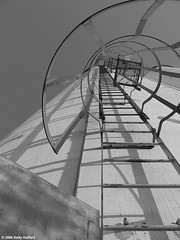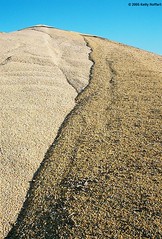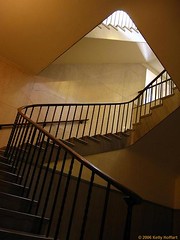Assignment 8: Leading Lines
Previous Assignment: Putting It in Perspective
I found a nice way to explain the topic, leading lines, over on Kodak's web site:
Select a camera angle where the natural lines of the scene lead the viewers' eyes into the picture and toward your main center of interest. You can find such a line in a road, a fence, even a shadow. Diagonal lines are dynamic; curved lines are flowing and graceful. You can often find the right line by moving around and choosing an appropriate angle.You can find a lot of good examples of this in the post on perspective, particularly the part on linear perspective, but here are a few examples of the technique:


Notice how the lines lead your eye into, and not out of, the picture, just as action should always lead into the picture. One of the best ways to do this is to start your leading line in the corner, as in the corn picture above. The corner is a place where the eye can easily wander out of the frame, and it's your job to draw the eye back in. You need to be careful, though, because you don't want it to go directly into the corner. That will lead the eye out. But you do want it to start very close to the corner.
A good way to judge whether you are using your leading lines effectively is to just sit and look at your picture, relax, and let your eye move where it will. Take this picture, for example:

Notice how your eye immediately wants to start in the lower right corner, and the railing leads your eye across and into the picture, but doesn't lead your eye out. Then it leads your eye up and to the right for a while, but the edge of the ceiling saves your eye from going out, leads your eye around and back down. This picture is a particularly good example of the use of leading lines because the lines draw your eye to every facet of the picture and keep your eye in the frame.
Leading lines are an excellent tool for portraiture, as well. When posing your subject, it's a good idea to use their arms, or some object, as a leading line. And it's a good idea to remember the golden triangle, as it's quite good for portraiture. See this example:

Notice how the elbow follows along with the golden triangle's lines, and it starts a leading line that leads up to the face. Just in case your eye wasn't sure where to go, the hilt (or tsuka) of the katana also draws your eye to the face. Notice also that the scabbard (or saya) is dark enough to be almost unnoticeable, so it doesn't draw your eye out of the frame. When doing portraiture, the face (and especially the eyes) are where you want the leading lines to go.
Leading lines are generally most effective when they are diagonal or curved, rather than horizontal or vertical. However, the best leading lines of all are the elusive S-curves. I don't have any good examples from my own work, but here are a couple from other people that I thought were awesome examples:

(by cobalt123)

(by ikonjon)
Aren't those last two amazing? I think so.
So why don't you go out, shoot, and share?
Next Assignment: Critique

1 Comments:
Leading curves are particularly elusive, but you've got some great examples there.
Post a Comment
<< Home